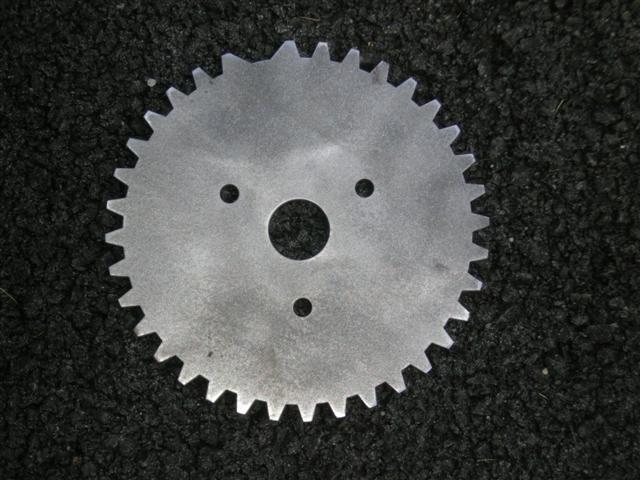

Users who want custom crank wheels for missing tooth applications (either direct decoder with MS-II or 36-1 for EDIS) can have custom wheels made at a number of places.
As an example, Bruce has made up a custom 36-1 missing tooth crank wheel for a small block Chevrolet. Here are photos (the tooth edge one is somewhat blurry):


It is very easy to make, just 10 minutes with AutoCAD Light 97 and emailing the .DXF file to Waterjet Cutting Service in Lynchburg, Virginia:
(Note that the latest version of AutoCad Light 2008 is $800 - you may wish to investigate alternatives that are compatible with the .DWG/.DXF formats.)
The cost for 1/8 inch mild steel stock (0.125" = 3mm, must use a ferrous material as it must be magnetic) for 7.5 inch teeth tip diameter was US$60.00 for two wheels. They arrived in the mail two weeks later - and they did a superb job! No touch up at all required, it is ready to bolt-on and use.
Drawing up the wheel in AutoCAD took 10 minutes. The only AutoCAD commands Bruce invoked were the following:
Bruce made the teeth tip match up with the sensor tip width. He is using a Magnetti-Marelli VR sensor (commonly available on eBay) and this has a ~0.175 inch (~4.5 mm) sensing element diameter.
If creating your own wheel, the wheel must be ferromagnetic - i.e., mild steel, not stainless or aluminum, etc.. You should carefully consider the tooth geometry.
In general, for the stongest, cleanest signal:
None of these are 'set in stone' but adhering as closely as practical to them will result in a better signal.
The tooth shape Bruce choose was more experimental, especially the missing one with the shallower slope of the trailing/leading edge. Using a rectangular/square tooth works, too, and is easier to generate.
For the VR sensor, you can adapt an OEM sensor (like the ford EDIS sensor), or google the AI-TEK (formerly Airpax) VR sensors (have a look at 70085-101-001 or 70085-1010-002)
Here are some really good links on VR sensors and timing wheel tooth geometry:
www.ai-tek.net/pdf/24_PrinciplesofOperation_VR6_2001.pdf
www.ai-tek.net/pdf/25_SensorSelection_6-2001.pdf
archives.sensorsmag.com/articles/0298/mag0298/index.htm
www.integratedsoft.com/papers/techdocs/tech_9mx.pdf